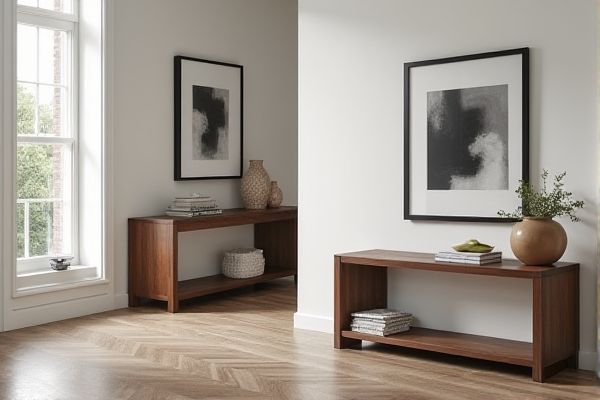
Split console tables separate the display and control functions into distinct units, enhancing organization and allowing flexible placement, while unified console tables combine these elements into a single cohesive unit for streamlined operation and a compact footprint. Explore this article to discover which console table design best fits your workspace and workflow preferences.
Table of Comparison
| Feature | Split Console Table | Unified Console Table |
|---|---|---|
| Definition | Separate consoles or interfaces display data distinctly. | Single console integrates data within one interface. |
| Data Management | Fragmented, requires manual consolidation. | Centralized, streamlined data access. |
| User Experience | Multiple views cause switching effort. | Consistent UI, reduced context switching. |
| Performance | Potential lag due to multiple consoles. | Optimized performance via unified backend. |
| Complexity | Higher, managing multiple consoles. | Lower, single point of management. |
| Use Case | Best when distinct data sets are managed separately. | Ideal for integrated monitoring and control. |
| Scalability | Challenging with increased consoles. | Easier with modular design. |
Introduction to Console Tables
Console tables serve as versatile furniture pieces in entryways, living rooms, or hallways, providing both functional storage and decorative appeal. Split console tables feature separate sections or tiers, allowing customized organization and a dynamic aesthetic, while unified console tables offer a seamless, single-piece design ideal for minimalist or streamlined spaces. Choosing between split and unified console tables depends on spatial needs, design preferences, and the desired balance between flexibility and cohesion in interior decor.
What Is a Split Console Table?
A split console table features a design where the tabletop is divided into separate sections or segments, often allowing for modular use or varied configurations. This design offers flexibility and can enhance functionality in spaces requiring adaptable furniture arrangements. Unlike a unified console table with a continuous surface, the split console emphasizes versatility and distinct visual separation between parts.
Understanding Unified Console Tables
Unified console tables consolidate multiple functions into a single interface, enhancing workflow efficiency by reducing the need to switch between separate consoles. This integration streamlines data management and control, offering a more cohesive user experience compared to split console tables that require interacting with distinct, segmented units. Emphasizing centralized control and real-time data synchronization, unified console tables optimize operational responsiveness in complex environments.
Design Differences: Split vs Unified Console Tables
Split console tables feature separate, modular components that offer flexibility in arrangement and style, often enhancing spatial adaptability in smaller rooms. Unified console tables present a single, continuous surface that emphasizes a streamlined, cohesive design, providing a solid visual anchor suitable for entryways or hallways. The design differences impact not only aesthetics but also functionality, with split consoles supporting multi-purpose use and unified models prioritizing structural stability and simplicity.
Functional Advantages of Split Console Tables
Split console tables offer enhanced customization by allowing you to position components separately for better ergonomics and space optimization. This design improves cable management and airflow compared to unified console tables, reducing clutter and enhancing system performance. You benefit from easier access to individual units, facilitating maintenance and upgrades without disrupting the entire setup.
Benefits of Unified Console Tables
Unified console tables streamline workflow by consolidating controls and displays into a single interface, reducing the need for multiple devices and minimizing desk clutter. This integration enhances real-time data access and improves decision-making speed, which is crucial in high-pressure environments. Your efficiency increases as a unified console table offers a more ergonomic layout, simplifying navigation and reducing operator fatigue.
Aesthetic Considerations and Style Options
Split console tables offer versatility by allowing for creative arrangement and variation in materials, which enhances visual interest and complements eclectic or modern interior styles. Unified console tables provide a cohesive, streamlined look that suits minimalist or traditional decor, emphasizing clean lines and uniform finishes. Your choice between split and unified options will influence the balance and flow of your space, shaping the overall aesthetic impact.
Space and Placement: Which Table Fits Your Room?
Split console tables offer flexibility by allowing multiple smaller tables to be arranged to fit different spaces, making them ideal for irregular or tight rooms. Unified console tables, designed as a single continuous piece, provide a streamlined look and require a dedicated wall or open area, best suited for larger rooms with more straightforward layouts. Your choice depends on whether you need adaptability in tight spaces or a cohesive statement piece for an open area.
Maintenance and Durability Comparison
Split console tables offer easier maintenance due to their modular design, allowing individual sections to be repaired or replaced without disturbing the entire unit. Unified console tables, while potentially more durable because of their solid, single-piece construction, can be harder to maintain as any damage may require comprehensive servicing. Your choice depends on whether you prioritize straightforward upkeep with split designs or long-term sturdiness with unified tables.
Choosing the Right Console Table for Your Home
Choosing the right console table for your home depends on your space and functionality needs; split console tables offer flexibility and easy portability with their segmented design, ideal for smaller or modular living areas. Unified console tables provide a cohesive and sturdy surface, perfect for displaying decorative items or supporting larger objects in more permanent setups. Consider the balance between mobility and stability when deciding between split and unified designs to complement your interior style and daily usage.
 homyna.com
homyna.com